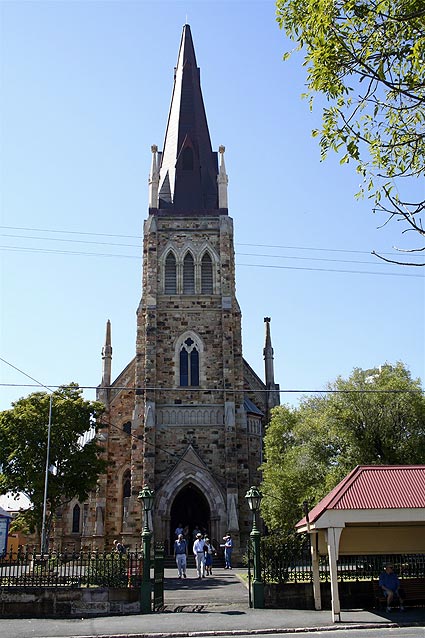
[Photograph by Trevor Bunning (October 2007)]

[Photograph by Trevor Bunning (October 2007)]
Historical and Technical Documentation by Geoffrey Cox
© OHTA 2007, 2011, 2017 (last updated August 2017)
St Paul's Presbyterian Church was constructed in 1887-89 to the design of the prominent colonial architect, F.D.G. Stanley. Much of the stone for the present building came from the demolished Creek-street Presbyterian Church, where the congregation (affiliated with the United Presbyterian Church of Scotland) had worshipped since 1863.1
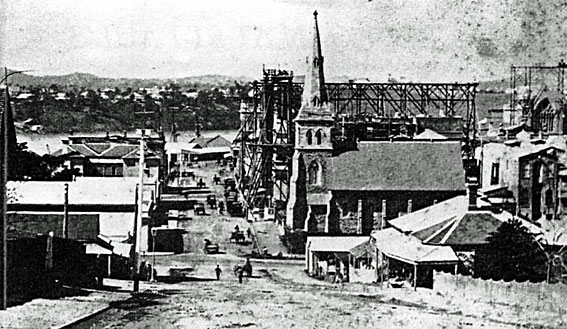
The Creek Street Presbyterian Church, Brisbane, c.1883
[Photograph supplied 2007 by Neil Taylor (organist)]
The site of the Creek Street Presbyterian Church was sold to the Queensland National Bank in July 1885, and the opening services at St Paul's were conducted on 5 May 1889.2 In the meantime, the brick and stone Sabbath School, erected on the corner of the present site in 1886, served as a temporary church.3
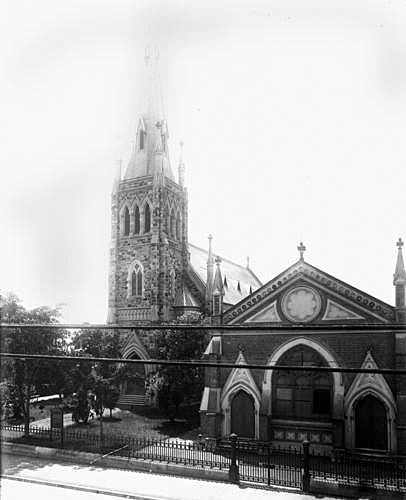
St Paul's Presbyterian Church and Sabbath School, c.1912
[Photograph: John Oxley Library, State Library of Queensland]
The organ in St Paul's Presbyterian Church had been purchased for the Creek Street church, where it was installed in 1883. It was ordered from Hill & Son of London in September 1882 and the estimated cost at that time was £530.4 The arrival of the instrument in Brisbane towards the end of February 1883 was heralded in the local press with details of the complete specification:
The following is the specification of the organ built by Messrs. Hill and Son, of London, for Creek-street Presbyterian Church, Brisbane, which has just arrived by the Dorunda:—Of great organ and swell, each 56 notes—CC to G3 in alto, with an independent pedal organ 30 notes, CCC to tenor F :—
Great
1 Open diapason
2 Dulciana
3 Stopped diapason bass }
and clarabella }
4 Flute
5 Principal
6 Twelfth
7 Fifteenth
8 Trumpet
Swell.
1 Bourdon
2 Open diapason
3 Lieblich Gedacht }
and stopped bass }
4 Viol de gamba
5 Principal
6 Fifteenth
7 Mixture
8 Horn
9 Oboe (capped)
Pedals.
1 Bourdon
Total number of pipes -
Metal
do.
Wood
do.
Metal
do.
do.
do.
Wood
Metal
Wood
Metal
do.
do.
do.
do.
do.
Wood
CC
tenor C
CC
CC
CC
CC
CC
CC
CC
CC
CC
tenor C
CC
CC
CC
CC
CC
CCC to tenor F
8ft.
8ft.
8ft.
4ft.
4ft.
2-2/3ft.
2ft.
8ft.
16ft.
8ft.
8ft.
8ft.
4ft.
2ft.
2 ranks
8ft.
8ft.
16ft.
Great
Swell
Pedal
56
44
12 }
44 } 56
56
56
56
56
56
___
436
56
56
44 }
12 } 56
44
56
56
112
56
56
___
548
30
436
548
30
_______
1014
Couplers—Swell to great.
Couplers—Swell to pedals.
Couplers—Great to pedals.
Three composition pedals to great.
Three composition pedals to swell.
One of Joy's patent hydraulic engines has been imported with the organ. The cost of the organ is £700.5
These details agree essentially with those given in the Hill & Son shop book, where the organ is described as Job No 1834, although the Great Flute 4ft is described in the shop book as 'Wald Flute'.6 The organ was installed on a handsome newly erected gallery in the Creek Street church.7 The official opening of the instrument, which took place on Sunday 6 May 1883, was described as follows in a newspaper report the next day:
Large congregations assembled in the Creek-street Presbyterian Church yesterday morning and evening on the occasion of the opening of the new organ. Mr R. Scott, the organist, fully tested the powers of the instrument during the day's services, and not a few spoke of it in terms of high praise. At the morning service the choir - about thirty strong - sang Kent's anthem, 'Thine, O Lord, is the Greatness.' The morning preacher was the Rev. Alexander Hay, of Rockhampton, and the evening preacher the Rev. J. G. Sterling, of Bundaberg.8
In a further report a few days later, there was a suggestion that a public organ recital should be arranged:
The organ recently imported for the Creek-street Presbyterian Church is acknowledged by competent authorities to be the best yet in this colony. It has been suggested that the organist and managing body of that church would confer a great favour on, and afford much pleasure to, a large class of music-lovers by arranging for a public organ recital to take place on some week-night, and at which all the organists in the city would take part. There has been no opportunity here for the citizens hearing high class music on the "king of instrument" beyond what is ordinarily heard at festival services in a few of our churches. The trouble in getting up a recital need not be very great, as there are many in Brisbane who would gladly give their assistance in carrying out the necessary arrangements, whilst the charges for admission should be such as to realise a sum sufficient to defray part of the cost of the instrument.9
Within a few months, the suggestion had been taken up, and Brisbane music lovers were treated to what was reportedly the first organ recital in Brisbane on Tuesday 31 July 1883. It involved four Brisbane organists: Madame Henrietta Mallalieu (at that time organist of St John's pro-Cathedral) and her husband Mr W.G. Willmore (organist of All Saints' Church), together with Mr P.C. Atkinson (formerly organist successively at All Saints' Church, St Stephen's old Cathedral and St John's pro-Cathedral) and Mr R.J. Scott (organist at the Creek Street Presbyterian Church). The complete programme was advertised on the front page of The Brisbane Courier on the day of the recital:10
|
|||||||||||||||
An extensive review that appeared in the same paper on the following day, describing the event as 'the first entertainment of the kind' in Brisbane:
ORGAN RECITAL
An organ recital, the first entertainment of the kind ever given in Brisbane, took place last evening in the Presbyterian church, Creek-street. The fine organ, built by Messrs Hill and Sons [sic], recently erected in the church has already been described in these columns. The music for last evening was judiciously selected to display the powers and quality of the organ, and when it is stated that the executants were Madame Mallalieu, Mr. Willmore, Mr. Atkinson, and Mr. Scott, the organist of the church, it is needless to say the whole programme was a musical treat. Of the organ itself it may be said that the effect of the full organ was not altogether satisfactory. It is somewhat harsh, and displays perhaps a want of breath. It was not, however, heard at its best last night; this is, we believe, attributable to the effect of the recent westerly winds, and no doubt it will soon mellow down. Some of the reeds are excellent, particularly the oboe. The claribella on the great organ is very good, and the viol-de-gamba, in combination with the gedact, is exceedingly pleasing. The hydraulic engine works very effectively, the pressure of water being great, keeping up an excellent pressure in the wind chest. On the whole, the full combination of the instrument is brilliant and powerful, and the pedals were pronounced by the executants to be good and effective.
The recital commenced with a grand sonata for four hands and double pedals, by Gustav Merkel, who is one of the best of the living German composers for the organ. It was faultlessly played by Madame Mallalieu and Mr. Willmore. This sonata, in three movements, was selected to display the power of the organ from full power to very soft. In the adagio, the softest movement, the open diapason was used as a solo stop. The third movement opens with a bold introduction, enters quietly into a fugue, with rather a long subject, and builds up quietly to the end. Mr. Atkinson followed with a selection from the "Creation" embracing "In Native Worth" and "The Marvellous Work", which was highly appreciated. The third number was an "Ave Maria", from one of Cherubini's masses, [sic] bracketed with "Quoniam", by Van Bree, played by the organist of the church, Mr. Scott. The first was selected to display the effect of the soft stops, and the second, introducing a fugato, to display the effect of the more powerful stops. The selection was a judicious one. A duet in the "Ave Maria" on the oboe on the swell and clarabella on the great, was exceedingly effective. A pastorale by Guilmant, a French organist, and written purposely to illustrate the effect of the oboe stop, was beautifully rendered by Mr. Willmore. In the course of this number a most agreeable effect was produced by employing one hand on the two manuals at the same time, thus producing a double melody. Madame Mallalieu concluded the first part by an exceedingly fine rendering of the second movement of Handel's 1st organ concerto, a brilliant composition, acknowledged to be the best of Handel's concertos.
Mr. Atkinson opened the second part with an adagio in F, by Haydn and later on played a selection from the "Messiah" introducing the air "But thou did'st not leave", and the grand "Hallelujah Chorus", which brought out the whole power of the instrument with telling effect. This was followed by an air with variations, played by Madame Mallalieu, a varied musicianly composition by Hiles, introducing a charming melody which showed off the solo stops, particularly the oboe, to perfection. In the fourth variation the oboe takes up the melody with a claribella obligato, and it was brought to close by a massive variation in E flat minor, with an elaborate pedal obligato. Mr. Willmore followed with a very effective fantasia, with an elaborate fugue at the end, by Freyer, a Polish composer. The fantasia is in the minor key, and concludes with a brilliant coda in the major key with scale passages for the pedals. The monotony of the first part of this number was varied by a bold movement for the diapason, skilfully introduced. The "Golden Trumpets", a composition by Fowles, somewhat resembling in style the celebrated "Tannhauser March", was carefully and tastefully rendered by Mr. Scott. Madame Mallalieu brought the programme to a conclusion by a superb rendering of Smart's grand solemn march, one of the most stately compositions ever written for the organ. It is needless to attempt a description of this composition. It must be heard to be appreciated.
Mr. Willmore is well known to be a cultured musician, and it is therefore unnecessary to say that he performed his part of the programme in a masterly manner and with great delicacy and taste. Madame Mallalieu we have long known in Brisbane as a gifted pianiste. She has now developed, with entire success, into an admirable concert organist, and with two such accomplished organists in our midst, it cannot be subject for regret that we have not a civic organ, so as to enjoy frequent opportunities of listening to entertainments like that of last night. Mr. Scott deserves the sincere thanks of music-lovers for affording them one of the greatest musical treates of the season, which, by the way, it is to be hoped, will not be the last by very many. Nor must we withhold our meed of praise to Mr. Christmas for the workmanlike manner in which he has put the instrument together in the church.11
'Mr Christmas' to whom reference is made at the end of this report was Thomas Christmas, who had previously worked in Melbourne as an organbuilder in partnership with John Abbott.12 He was listed in the Queensland Post Office Directory from at least 1883 until as late as 1902, and is known to have installed several organs in Brisbane, Rockhampton and Townsville between 1883 and 1885.
The instrument served for only a relatively short time in the Creek Street church, and was re-located to St Paul's Church when the congregation moved there in May 1889. Following the closure of the Creek Street church in 1885, it was placed in storage, and suffered flood damage in 1887.13 Installed at St Paul's in time for the opening on 5 May 1889, the organ was initially placed in the apse at the front of the church.14
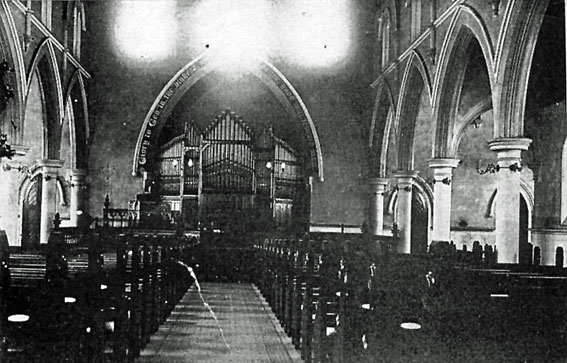
The Hill & Son organ in the apse at St Paul's, c.1890?
[Photograph supplied 2007 by Neil Taylor (organist)]
The organ appears to have been moved to its present position in the transept on the right-hand side of the nave in 1891, when the following was reported:
The deacons of St Paul's Presbyterian Church, Leichhardt-street have decided to remove the pulpit from the side of the church to the rear of the sacristy, and in consequence, the keyboard of the organ has also to be changed. The work is being carried out by Messrs W. H. Paling and Co. and is likely to be completed at the end of the week. The alteration would greatly improve the acoustic properties of the building.15
As Mr B.B. Whitehouse served as 'head tuner' for W.H. Paling & Co between c.1888 and c.1895, he was undoubtedly responsible for the removal of the organ to its new location at this time.16 The outer flats of the casework, which were originally angled backward on either side, were brought into line with the central flat.
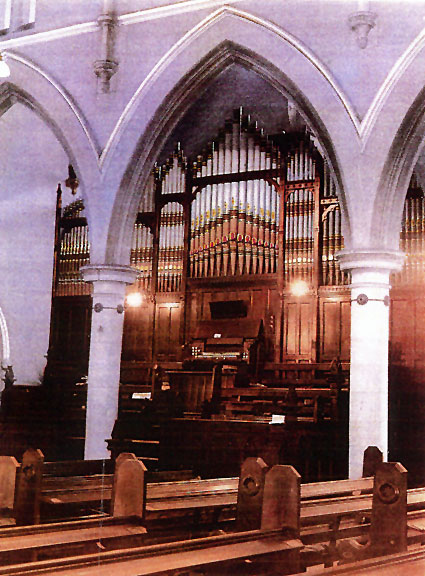
The Hill & Son organ in its present position, before 1963
[Photograph supplied 2007 by Neil Taylor (organist)]
The organ retained its original soundboards and mechanical action until 1963, when it was rebuilt with electro-pneumatic action by Whitehouse Bros of Brisbane. A new detached drawstop console was provided, four stops were added to the Pedal Organ, and the original slider chests were replaced with new sliderless cone-pallet chests.17 The opening recital on the rebuilt instrument was given on 10 September 1963 by William Pierce.18
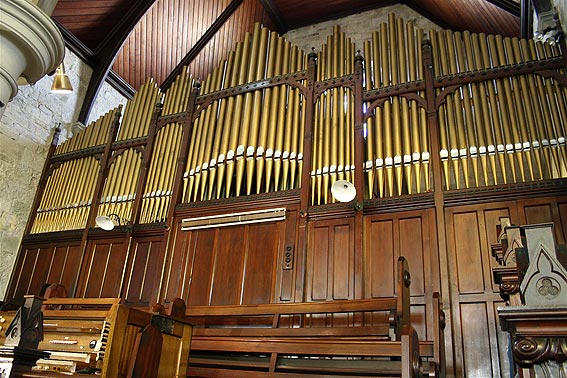
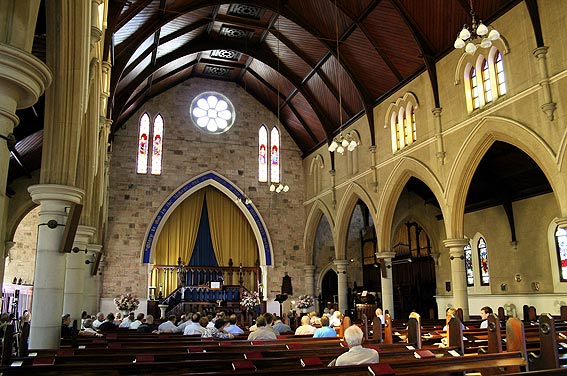
The rebuilt organ of 1963
[Photographs by Trevor Bunning (October 2007)]
The original Hill & Son nameplate, which has been retained on the present console, has at some stage had the figures '1834' engraved onto it, apparently having been mistaken for a date. Hill's nameplates did not bear dates, and it is clear that this represents the job number (1834) found inside the organ.
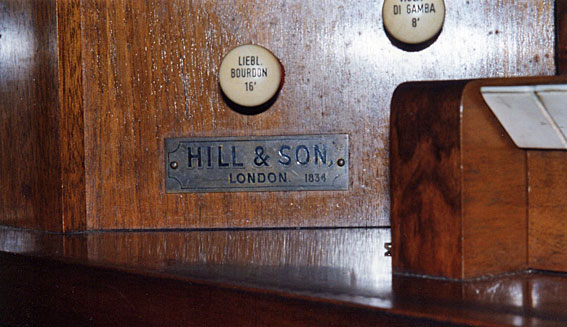
The Hill & Son nameplate, on which the Job Number '1934' has been engraved
[Photograph by Geoffrey Cox (October 2007)]
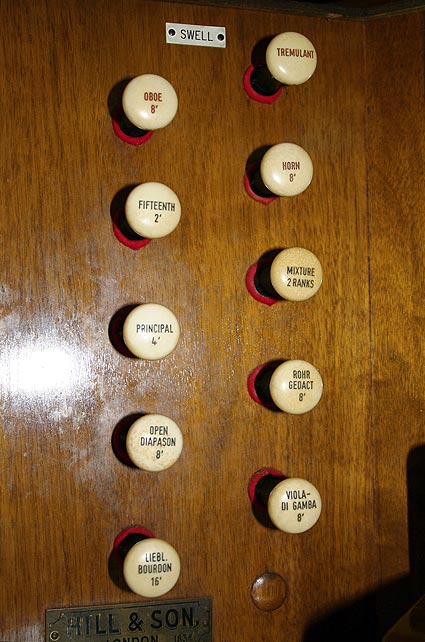
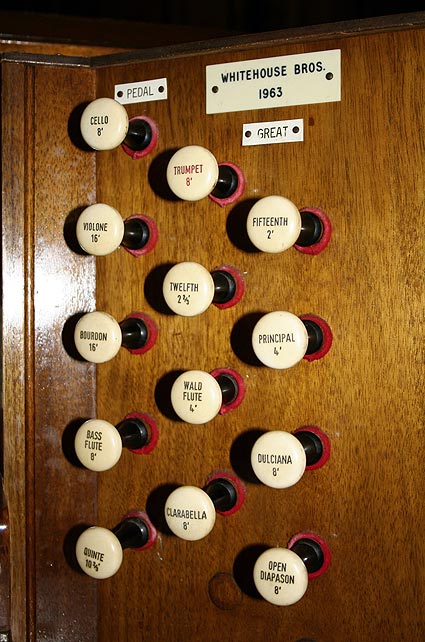
The Stop Jambs on the 1963 Whitehouse console
[Photographs by Trevor Bunning (October 2007)]
| GREAT Open Diapason Dulciana Clarabella Principal Wald Flute Twelfth Fifteenth Trumpet SWELL Lieb[lich] Bourdon Open Diapason Viola di Gamba Rohr Gedact Principal Fifteenth Mixture Horn Oboe PEDAL Bourdon Violone Quinte Bass Flute Cello COUPLERS Great to Pedal Swell to Pedal Swell to Great Great Super Octave Swell Super Octave Swell Sub Octave Swell Unison Off Swell to Great Super Octave Swell to Great Sub Octave |
8 8 8 4 4 2-2/3 2 8 16 8 8 8 4 2 II 8 8 16 16 10-2/3 8 8 |
A B A A B |
[1963] [1963] [1963] [1963] [1963] [1963] [1963] [1963] [1963] [1963] |
Swell tremulant
Compass: 61/32 (originally 56/30)
4 thumb pistons to Great
4 thumb pistons to Swell
4 toe pistons to Swell
4 toe pistons to Pedal
Full-organ piston
General cancel
Great and Pedal Combinations coupler
Detached drawstop console
Balanced swell pedal
Electro-pneumatic action.19
Parts of the organ were refurbished by H.W. Jarrott and Neil Taylor (organist) around 2008-15, including the provision of a new blower and releathering of the bellows.20
The pipework of the Great Organ was removed and cleaned in 2016, and that of the Swell Organ in early 2017, by Ian D. Brown and Associates of Ballina, at which time irregularities of voicing were corrected.21
Apart from some minor changes of nomenclature and the additions to the Pedal Organ, the specification of the organ remains essentially as Hill intended. The cone-pallet chests and electric action and console, however, date from 1963, and the bellows are no longer double-rise. The only parts of the original Hill & Son organ that survive are the pipework and the re-configured case.
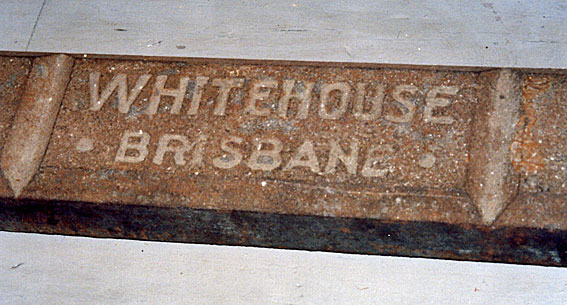
Whitehouse Bellows Weight
[Photograph by Geoffrey Cox (October 2007)]
____________________________________________________________________________
1 Queensland Heritage Council, Queensland Heritage Register, location 600309; Richard Bardon, The Centenary History of The Presbyterian Church of Queensland (Brisbane: W.R. Smith & Paterson, 1949), p. 219.
2 The Brisbane Courier (14 July 1885), p. 4; The Queenslander (18 July 1885), p. 85; The Brisbane Courier (4 May 1889), p. 3.
3 Queensland Heritage Council, Queensland Heritage Register, location 600309; The Brisbane Courier (14 June 1886), p. 4.
4 Hill & Son Estimate Book 2B (1877-89), pp. 247-48 (British Organ Archive, Birmingham).
5 The Brisbane Courier (24 February 1883), p. 3; The Queenslander (24 February 1883), p. 293.
6 Hill & Son Shop Book 2 (1875-84), p. 153 (British Organ Archive, Birmingham).
7 The Brisbane Courier (5 May 1883), p. 5
8 The Brisbane Courier (7 May 1883), p. 5.
9 The Brisbane Courier (10 May 1883), p. 5.
10 The Brisbane Courier (31 July 1883), p. 1.
11 The Brisbane Courier (1 August 1883), p. 5.
12 Sands & McDougall Directory (1877), p. 231; Graeme Rushworth, A Supplement to Historic Organs of New South Wales: The Instruments, Their Makers and Players, 1791-1940 (Organ Historical Trust of Australia, 2006), pp. 102-04.
13 Neil Taylor, The Pipe Organ at St Paul's Presbyterian Church, rev. edn (privately printed, July 2007).
14 The Brisbane Courier (4 May 1889), p. 3.
15 The Brisbane Courier (27 August 1891), p. 4; Queensland Heritage Register, op. cit, gives the date of the interior redesign as 1901.
16 Geoffrey Cox, 'B.B. Whitehouse and the First Organ Built in Queensland,' OHTA News, vol. 35, no. 1 (January 2011), pp. 19-24.
17 Date on Whitehouse Bros nameplate; Personal communication to G. Cox from Bruce Lang, January 2001.
18 Taylor, op. cit.
19 Specification noted by G. Cox, 1972 and 2007.
20 Personal communication to G. Cox from Doug Milne, August 2017.
21 Ian D. Brown & Associates, Newsletter (December 2016), p. 3; Newsletter (June 2017), pp. 2-3, rpt in The Sydney Organ Journal, vol. 48, no. 4 (Spring 2017), p. 48.